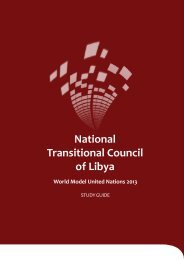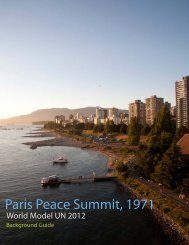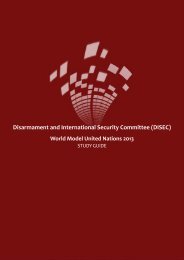Social, Humanitarian and Cultural Committee (SOCHUM)
Social, Humanitarian and Cultural Committee (SOCHUM)
Social, Humanitarian and Cultural Committee (SOCHUM)
Create successful ePaper yourself
Turn your PDF publications into a flip-book with our unique Google optimized e-Paper software.
find a job, they are usually employed in unskilled <strong>and</strong><br />
underpaid positions such as domestic or construction<br />
workers or small street vendors. Because of these<br />
low-paying jobs, indigenous populations in cities are<br />
dependent on social services from the government<br />
though many do not have access to these benefits for<br />
varied reasons.<br />
The lack of adequate housing is another serious<br />
problem for indigenous peoples in cities. They<br />
often reside in informal settlements <strong>and</strong> slums on<br />
the outskirts of the traditional city center that are<br />
overcrowded <strong>and</strong> do not have sufficient sanitation<br />
facilities, electricity, <strong>and</strong> other amenities. these<br />
settlements <strong>and</strong> slum are never constructed with<br />
long-term settlement in mind, so they are susceptible<br />
to mudslides <strong>and</strong> erosion, exposing residents to<br />
danger. 162<br />
An example of an indigenous group that has<br />
encountered intense discrimination after urbanization<br />
is the Murle community of South Sudan. in a search<br />
for increased employment opportunities, many Murle<br />
families migrated to the regional capital, Bor. in Bor,<br />
however, they have been unable to find jobs or get<br />
adequate housing because of the discrimination that<br />
they have faced from the majority ethnic group, the<br />
Dinka. Much of the economy of Bor is still based on<br />
agriculture, <strong>and</strong> the Murle community often faces<br />
revenge attacks from the Dinka for cattle death, even<br />
when there is no evidence that the Murle people had<br />
any involvement in deaths in the first place. The Dinka<br />
also harass the Murle when they hear them using<br />
their indigenous language around town. 163<br />
Current Situation<br />
Statistics about the current state of poverty among<br />
indigenous populations make clear the seriousness<br />
of the problem the international community is facing<br />
today. Rates of poverty among indigenous peoples<br />
are significantly higher than those among nonminority<br />
groups. Overall, indigenous peoples make<br />
up between four <strong>and</strong> five percent of the world’s total<br />
population, a small but substantial minority. When<br />
we restrict our focus to the world’s poor population,<br />
however, the relative size of the indigenous<br />
population dramatically increases; it is estimated that<br />
been ten <strong>and</strong> fifteen percent of the world’s poor are<br />
members of indigenous minorities. 164, 165 Given the fact<br />
that many indigenous peoples reside outside of urban<br />
centers, it is not surprising that they make up an even<br />
higher portion (around one-third) of the world’s rural<br />
poor population. 166 Of all of the indigenous peoples<br />
throughout the world, just over one-third live in<br />
poverty. 167<br />
As will be discussed below, one of the major<br />
obstacles in solving the problem of poverty among<br />
indigenous peoples is the lack of information on the<br />
current condition that such populations are facing in<br />
different regions. That being said, the information<br />
that we do have on indigenous poverty presents a<br />
dire reality. Latin America, with its sizeable indigenous<br />
population, provides a good case study. Across the<br />
region, rates of poverty among indigenous peoples are<br />
significantly higher than those among ethnic majority<br />
groups. In Peru, for example, 65% of the indigenous<br />
population lives in poverty, as opposed to 43% of the<br />
general population. 168 Bolivia <strong>and</strong> Guatemala have<br />
even higher rates, with about half of the population<br />
under the poverty line, including three-quarters of all<br />
indigenous peoples. In the Latin American country<br />
with the highest poverty rates, Ecuador, only one in<br />
ten members of indigenous communities do not live<br />
in poverty; as suggested above, the problem is even<br />
more pronounced in rural areas, with 96% of rural<br />
indigenous Ecuadorians under the poverty line. 169 the<br />
issue of poverty among indigenous peoples in Latin<br />
America affects not only the indigenous communities<br />
themselves but also the general population. In<br />
Mexico, for example, rates of extreme poverty are<br />
almost five times higher in regions with significant<br />
40<br />
Melbourne Host Directorate PTY LTD | Office of Media <strong>and</strong> Design

















